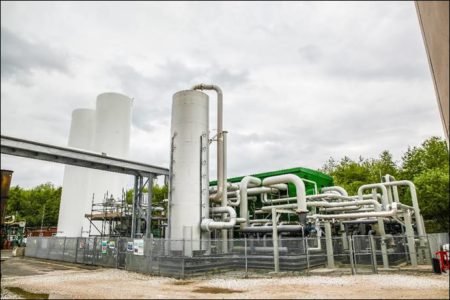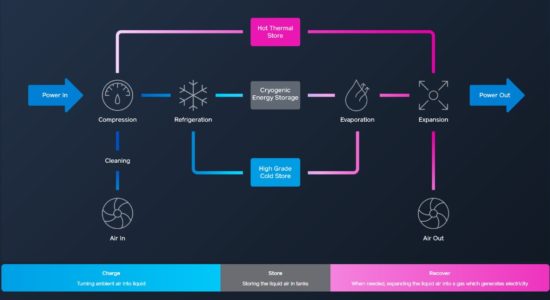October 24, 2019 – A United Kingdom company, Highview Power, has built the first modular cryogenic energy storage system called the CRYOBattery. The energy it stores is sufficient to power 200,000 homes daily.
How does it work?
Ambient air when cooled sufficiently to temperatures of -196 Celsius (-320 Fahrenheit) degrees, turns into a liquid that can then be stored in low-pressure, insulated vessels. When the liquid air is then exposed to room temperature its rapid expansion as it becomes a gas can be utilized to generate a sufficient force to drive a turbine.
Just how much does the air expand when going from a liquid back to a gas? 700 times the volume, yielding a significant amount of force.
The patented technology was launched in 2018 and is already drawing interest from energy utility companies and engineers from Finland to Spain, South Africa, and the Middle East.
Highview recently partnered with Citec, a Finnish company, to turn its proof of concept battery into a modularized system that grows from 50 to 500 Megawatts. This is the technology the company intends to sell globally.
What makes the CRYOBattery unique?
- It is the first battery to take full advantage of a free resource, the air surrounding us.
- There is no requirement for combustion in power generation.
- There are no pollutants in this zero-emission technology.
The CRYOBattery combines three processes that form a complete thermodynamic cycle including charging, energy storage, and power recovery. The schematic displayed below shows how it works.
CRYOBattery can be collocated with an existing facility such as a thermal-power plant, a liquid-natural-gas regasification plant, peaking plants, and manufacturing plants such as steel mills where it can use the waste heat and cold from their processes to power its thermodynamic cycle.
First tested at Slough Heat and Power, a Greater London utility, over a three year period from 2011 to 2014, the technology continues to be tweaked at the University of Birmingham Centre for Cryogenic Energy Storage. In April 2018, the first fully operational demonstration plant was constructed at the Pilsworth Landfill site in Greater Manchester (see image below) where it captured the waste heat for kickstarting cryoconversion of the air.
The CRYOBattery is capable of operating in standalone mode as well. But at Pilsworth it is coupled to the landfill gas and heat recovery system. It similarly can be coupled with other power generation facilities.
The CRYOBattery can be easily fabricated and run anywhere and has a rated lifespan of 30 plus years producing power from thin air. And even better it is a zero-emission technology that is 60% energy conversion efficient in standalone and 70% efficient attached to an existing facility.
The company estimates the market size for energy storage by 2040 to be as much as $1.1 trillion with forecasted cryogenic energy storage contributing just under $300 billion in revenue for operators while generating 208 GigaWatts of power for lighting, and heating.
Alex Eller, a Senior Analyst with Navigant Research, states, “Long-duration technologies such as cryogenic energy storage will become increasingly necessary for an electricity system to transition from a primary reliance on conventional fossil fuel generation to a grid dominated by variable renewable generation from solar and wind.”
The CRYOBattery was recently named the winner of the 2019 Ashden Award for Energy Innovation, an award given annually for achievements in increasing access to sustainable energy.










